
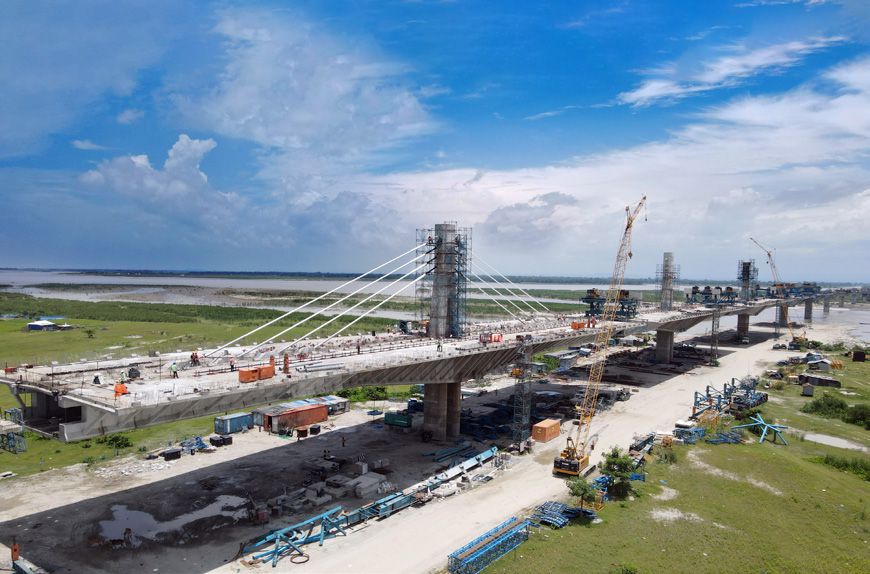
First stay cable installed, marking the commencement
of superstructure works with 125 m span length
across the Brahmaputra River
A transportation infrastructure of national significance is taking shape across the mighty River Brahmaputra as a TI IC team led by Project Director, V R Saravana Kumar, constructs India’s longest river bridge, the Dhubri-Phulbari. This 4-lane, 19.282 km long, JICA-funded bridge for the National Highways & Infrastructure Development Corporation Limited, will vitally link the North East to the rest of the country, connect the States of Assam & Meghalaya, boost trade & commerce and serve as a lifeline to over 31 lakh people in Assam’s Dhubri and South Salmara-Mankachar districts and Meghalaya’s West Garo Hills. The bridge will dramatically shrink a 212-km journey to a mere 20 km, 15-minute ride across the river. “This is a project befitting our status as nation builders,” beams a proud Saravana Kumar, “and a gamechanger in its truest sense.”
Time, weather, floods, shifting sands and a river with a mind of its own are only some of the challenges the team faces as they strive to construct the bridge constituting a 12.625-km main bridge, 5.735 km of approach viaducts, 0.922 km of embankments, and 198 spans ranging from 60 to 125 m, supported by teams from EDRC and CMPC, a charged band of project warriors and of course, their various technology-led solutions.
Efficient surveying with Total Station & DGPS integration
Accurately, speedily & cost-effectively surveying a riverbed is tricky at the best of times but surveying a difficult terrain, comprising both land and water was particularly difficult. The answer, according to Digital Officer Jim J R, lay in deploying Total Station for short-range, high-precision surveying, that boasts an accuracy of up to 1 mm in distance and 1 second in angular measurement. Effective up to a range of 500 m, Total Station was ideal for detailed ground-level work, however, insufficient for large-scale data acquisition.
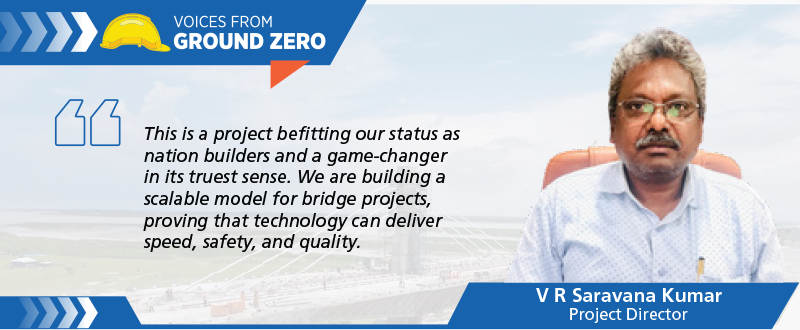
“That is why we integrated Differential GPS (DGPS) into the workflow for long-range, and reliable positioning across the variable terrain,” says Jim, with a thumbs up, “and although the standard effective range of DGPS is typically 2 km, we successfully extended it to 12 km by employing external radio communication systems.” The carefully calibrated DGPS, along with rovers, had a base station established at the midpoint of the alignment from where it could cover up to 12 km towards Dhubri and 12 km towards Phulbari, provide mmlevel accuracy for pier and span placement, even in marine and flood-prone areas. “Apart from ensuring continuity and accuracy throughout the entire project stretch, DGPS could reach areas inaccessible by conventional equipment, reducing manpower requirements and saving us valuable time during fieldwork.” Jim’s smile says it all.
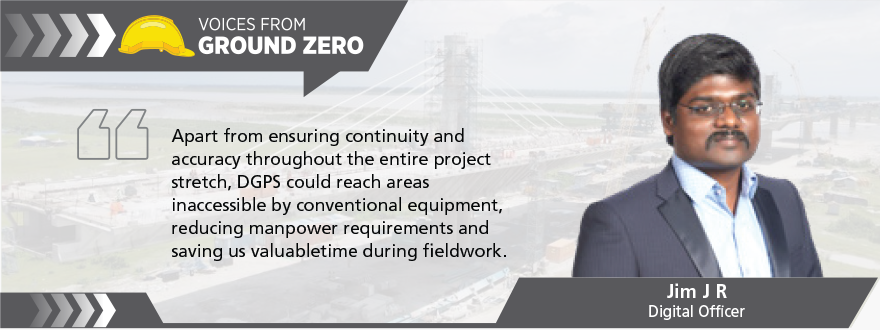
Modular formwork systems have rewritten the rules
Modular formwork systems that are easy to assemble, reusable, and adaptable to varied segment geometries have rewritten the ground rules in the pier table casting process by significantly boosting efficiency, sharply reducing cycle times and vastly improving casting quality. “Another huge advantage for us was the elimination of the need to erect a third lift staging as modular formwork enables independent casting of the first and second lifts,” says a jubilant Planning Head, Abhirup Deshmukh, “that reduced the cycle of Phase 2 from 18 days to 15 days that in turn accelerated our entire construction timeline.”
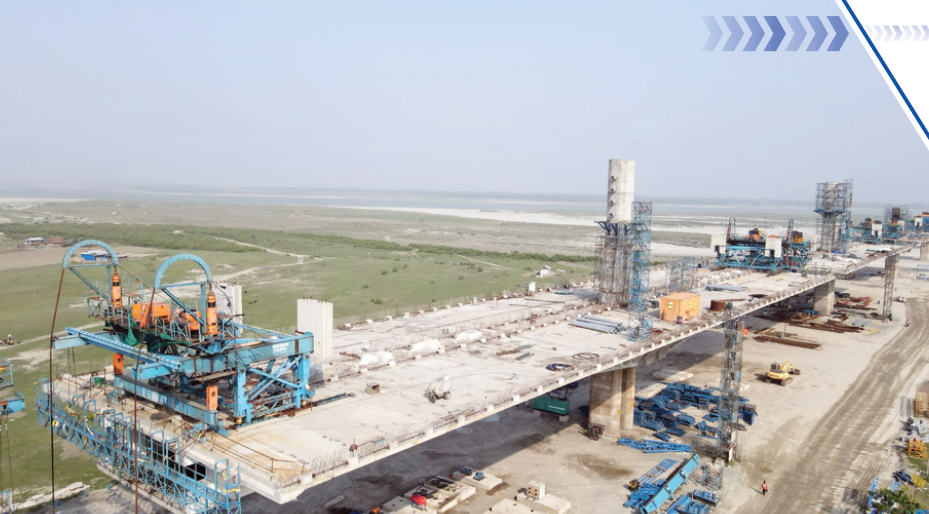
Upper pylon and segmental deck construction progressing using
bridge builders in deep-water conditions, enabling balanced
cantilever erection over the main channel
Moreover, modular formwork systems are both cost-effective and sustainable because they offer higher number of reuse cycles compared to conventional formwork. By streamlining assembly and adapting seamlessly to design variations, modular formwork has certainly improved the speed and quality of pier table construction. The introduction of semiautomated moulds have further reduced manual intervention, enhanced consistency and safety by limiting exposure to heavy equipment and wet concrete.
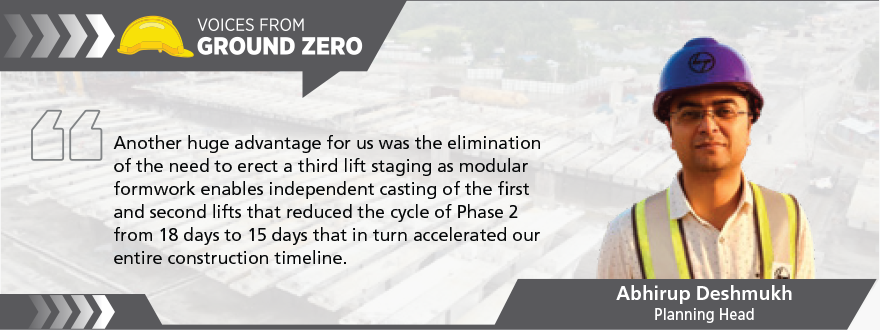
A full suite of tech tools driving precision & control
A customized digital app for segment casting & erection: To cast & erect 8,000+ precast segments of the bridge, the project team developed a customized digital App to monitor the entire segment lifecycle, right from mould preparation and concrete pouring to curing and erection. “Apart from realtime control, the digital App optimizes resource allocation, reduces idle time and overall cuts inefficiencies,” says Project Manager, Ashok Kumar Singh, “and by enabling yard-to-yard benchmarking, it has notably reduced cycle times, accelerated erection schedules, and enhanced productivity across our casting yards.”
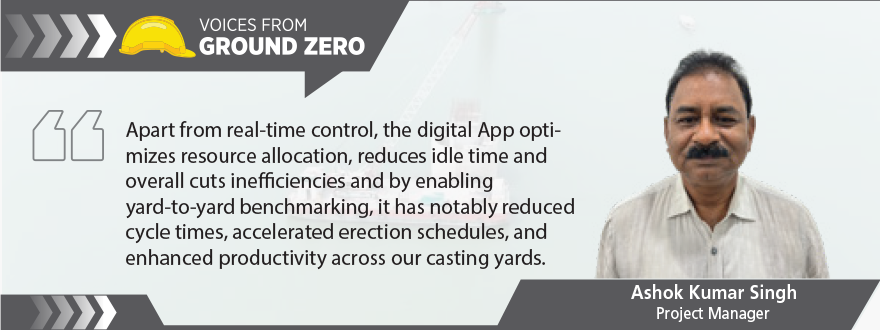
ABES: To be precise about the complex geometry of the bridge, the team has deployed ABES, a specialized geometry control software, to ensure dimensional accuracy, validate segment dimensions, and provide real-time installation feedback to ensure proper alignment. “ABES minimizes manual measurement errors and integrates survey data to maintain longitudinal and transverse geometry/ alignment across the entire 19.282 km stretch,” highlights Quality Head, Dave Ketankumar Jyotindrakumar, “keeping our tolerances within ±1 mm and ensuring structural integrity and seamless span transitions across the entire stretch.”
BIM empowers the team to detect clashes, identify and resolve design conflicts before construction begins that have streamlined coordination between the civil, structural, and MEP teams, minimizing delays and rework.
AssetInsight: GPS-enabled vehicles, equipment, and machinery feed data into a central dashboard, enabling 24/7 monitoring and predictive maintenance to maximize uptime. “AssetInsight has been a boon to us paving the way for real-time asset allocation, optimized fuel consumption and increased equipment productivity,” says Mariyappan, the Head of P&M.
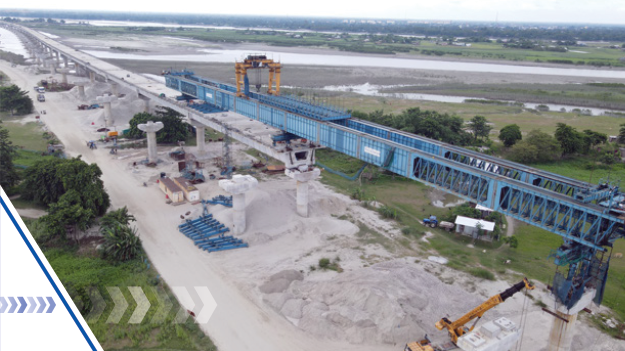
Launching Girder erects 20 precast segments per span, each measuring 60 m, enabling span-by-span construction
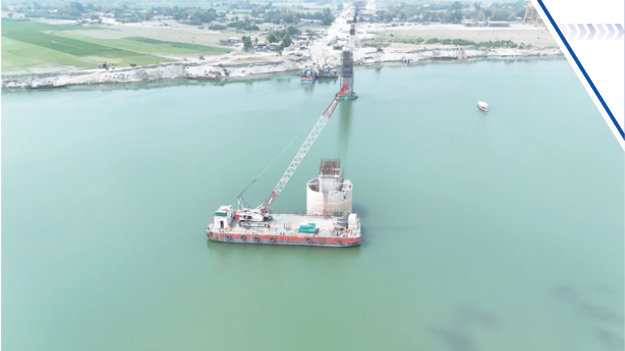
Lower pylon marine substructure works underway, in high-flow river conditions
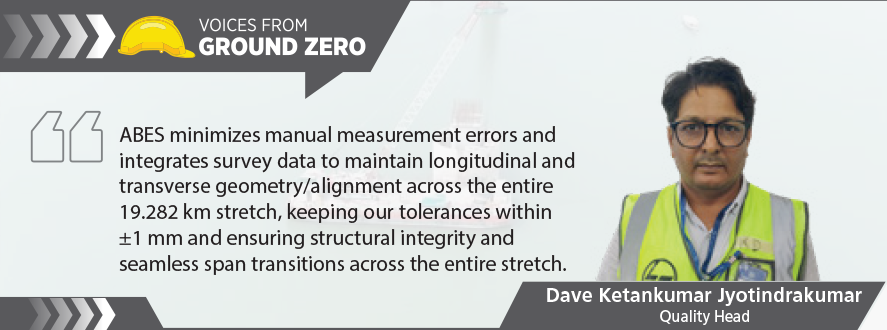
Batching Plant Monitoring: Real-time analysis of the concrete mix design ensures consistency in quality and reduces material wastage by detecting anomalies instantly.
Smart weighbridges: All weighbridges at the project site are cloud-connected for real-time material tracking, better logistics planning and operational transparency. “With instant access to live and tamper-proof weighment data, our records of material movement are accurate and authentic helping us to plan and take more informed decisions,” says Abhirup. The scope for manual intervention or manipulation is virtually eliminated, thereby increasing trust and accountability across operations. “This set-up feeds into a real-time IoT-enabled dashboard, offering a centralized view of weighment activity, vehicle turnaround time, and material flow resulting in faster processing, streamlined workflows, and smarter, data-driven site management,” adds Jim.
Quality App: enables proactive Non-Conformance Report (NCR) management, empowering internal teams to resolve issues before client escalations that has significantly reduced client-raised NCRs by 80%, improving quality assurance and client satisfaction.
SHEILD App: has quickened resolution of safety-related issues and increased accountability with a marked improvement in safety culture and behavioral awareness across the workforce. “The ease of reporting Unsafe Acts and Conditions (UA/UC) has empowered employees to take immediate preventive action against unsafe behaviors, encouraging accountability at every level,” states a satisfied EHS Head, Raghavendra Singh.
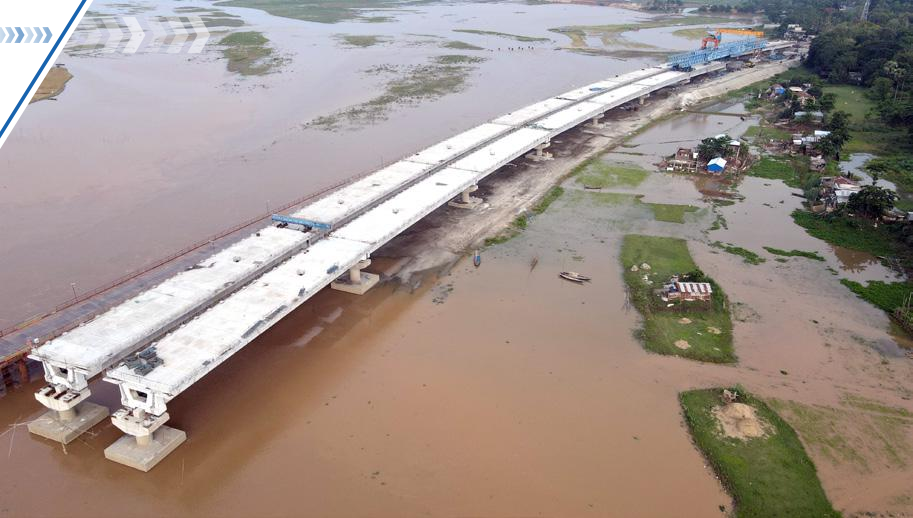
The Launching Girder at work to erect precast spans
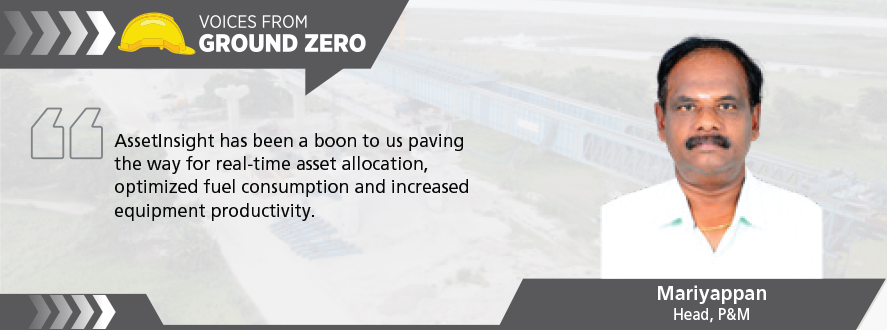
Workman Management System: This biometric-based system tracks workforce attendance and deployment, enabling better manpower planning, compliance and a fair distribution of labour across the project. “By leveraging facial recognition technology, we eliminate manual errors, proxy attendance, and fraudulent timekeeping practices that often challenge traditional workforce management,” notes Ashok.
The “No biometric, no payment” policy ensures that only workers who are authenticated and physically present receive wages, eliminating payroll discrepancies and providing a comprehensive audit trail for regulatory compliance & wage settlements boosting statutory adherence and simplifies inspections.
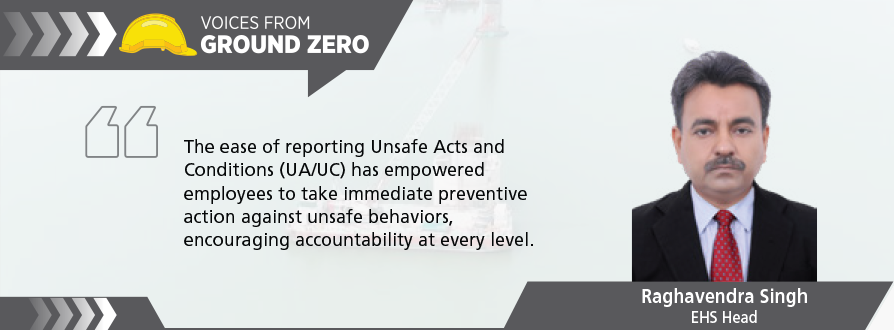
From a sustainability perspective, solar panels power the site office, reducing reliance on conventional energy, while a solarpowered vehicle supports on-site mobility, cutting the project’s carbon footprint.
The Dhubri-Phulbari Bridge project is a showcase of human grit combined with the power of technology to conquer scale and complexity in an extremely challenging environment. “We are building a scalable model for bridge projects, proving that technology can deliver speed, safety, and quality,” affirms Saravana Kumar as the project advances toward its 2028 completion deadline.